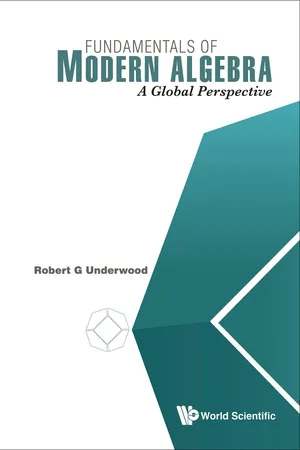
- 232 pages
- English
- ePUB (mobile friendly)
- Available on iOS & Android
About this book
The purpose of this book is to provide a concise yet detailed account of fundamental concepts in modern algebra. The target audience for this book is first-year graduate students in mathematics, though the first two chapters are probably accessible to well-prepared undergraduates. The book covers a broad range of topics in modern algebra and includes chapters on groups, rings, modules, algebraic extension fields, and finite fields. Each chapter begins with an overview which provides a road map for the reader showing what material will be covered. At the end of each chapter we collect exercises which review and reinforce the material in the corresponding sections. These exercises range from straightforward applications of the material to problems designed to challenge the reader. We also include a list of "Questions for Further Study" which pose problems suitable for master's degree research projects.
Request Inspection Copy
Contents:
- Groups
- Rings
- Modules
- Simple Algebraic Extension Fields
- Finite Fields
Readership: Graduate students in algebra.
Groups;Rings;Modules;Algebraic Extension Fields;Finite Fields Key Features:
- A broad range of essential topics in modern algebra are included in a relatively short book
- The fundamental results on the structure of groups, namely the structure theorem for finitely generated abelian groups, Cauchy's Theorem and Sylow's Theorems are included
- We include a detailed discussion of localizations and absolute values and completions. There is a natural progression from modules over fields (vector spaces) to modules over Noetherian rings. We also include a thorough discussion of the discriminant which leads to a concise yet readable introduction to algebraic number theory
Frequently asked questions
- Essential is ideal for learners and professionals who enjoy exploring a wide range of subjects. Access the Essential Library with 800,000+ trusted titles and best-sellers across business, personal growth, and the humanities. Includes unlimited reading time and Standard Read Aloud voice.
- Complete: Perfect for advanced learners and researchers needing full, unrestricted access. Unlock 1.4M+ books across hundreds of subjects, including academic and specialized titles. The Complete Plan also includes advanced features like Premium Read Aloud and Research Assistant.
Please note we cannot support devices running on iOS 13 and Android 7 or earlier. Learn more about using the app.
Information
Chapter 1
Groups
1.1Introduction to Groups


Table of contents
- Cover page
- Title page
- Copyright page
- Dedication
- Preface
- Contents
- 1. Groups
- 2. Rings
- 3. Modules
- 4. Simple Algebraic Extension Fields
- 5. Finite Fields
- Bibliography
- Index